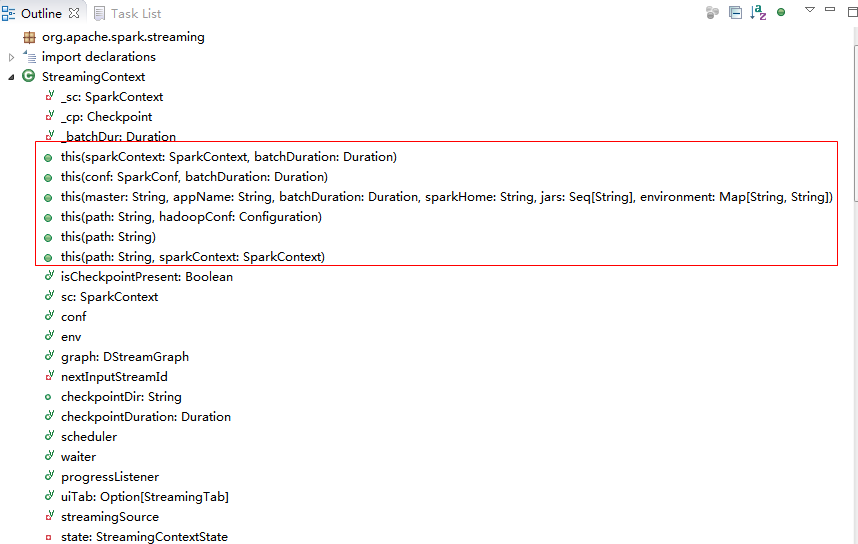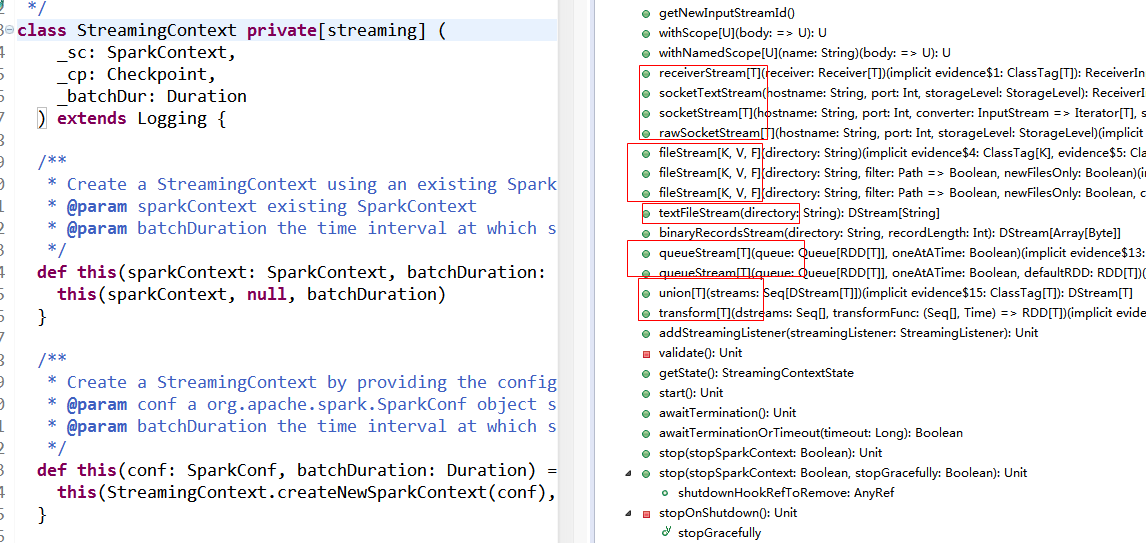1.1 创建StreamingContext对象

1.1.1通过SparkContext创建
源码如下:
def this(sparkContext: SparkContext, batchDuration: Duration) = { this(sparkContext, null, batchDuration) }
第一参数为sparkContext对象,第二个参数为批次时间;
创建实例:
val ssc = new StreamingContext(sc, Seconds(5))
1.1.2通过SparkConf创建
源码如下:
def this(conf: SparkConf, batchDuration: Duration) = { this(StreamingContext.createNewSparkContext(conf), null, batchDuration) }
第一参数为SparkConf对象,第二个参数为批次时间;
创建实例:
val conf =new SparkConf().setAppName("StreamTest")
val ssc = new StreamingContext(conf,Seconds(5))
1.1.3通过SparkConf参数创建
源码如下:
def this( master: String, appName: String, batchDuration: Duration, sparkHome: String = null, jars: Seq[String] = Nil, environment: Map[String, String] = Map()) = { this(StreamingContext.createNewSparkContext(master, appName, sparkHome, jars, environment), null, batchDuration) }
第一参数为需要创建SparkConf对象的详细参数,master-spark地址,appName-对象名称,sparkHome- sparkHome环境变量,jars, environment,第二个参数为批次时间;
创建实例:
val ssc = newStreamingContext(“ spark://host:port”, "StreamTest", Seconds(5), System.getenv("SPARK_HOME"),StreamingContext.jarOfClass(this.getClass))
1.1.4通过checkpointfile参数创建
源码如下:
def this(path: String, hadoopConf: Configuration) = this(null, CheckpointReader.read(path, new SparkConf(), hadoopConf).orNull, null)
第一参数为checkpoint file的路径,第二个参数为haoop的配置
1.2创建Dstream监听对象

1.2.1 fileStream
val ssc = new StreamingContext(sparkConf, Seconds(10)) ssc.fileStream(directory)
源码如下:
/** * Create an input stream that monitors a Hadoop-compatible filesystem * for new files and reads them using the given key-value types and input format. * Files must be written to the monitored directory by "moving" them from another * location within the same file system. File names starting with . are ignored. * @param directory HDFS directory to monitor for new file * @tparam K Key type for reading HDFS file * @tparam V Value type for reading HDFS file * @tparam F Input format for reading HDFS file */ def fileStream[ K: ClassTag, V: ClassTag, F <: NewInputFormat[K, V]: ClassTag ] (directory: String): InputDStream[(K, V)] = { new FileInputDStream[K, V, F](this, directory) }
参数:K-读入HDFS的Key的类型,V-读入HDFS的Value的类型,F-读入HDFS的类型;directory-监听HDFS的路径,filter-对监听HDFS的文件进行过滤的函数,newFilesOnly-是否只监听新增文件;
fileStream可以通过设置filter函数,对监听目录下的文件进行过滤,只对满足条件的文件进行监听和处理;
默认过滤方法:
def defaultFilter(path: Path): Boolean = !path.getName().startsWith(".")
该方法是过滤以隐藏文件。
fileStream可以通过设置newFilesOnly为TRUE或者FALES,是否处理监听目录下已存在的文件,默认是不处理已存在文件,只处理新增加文件,如果设置为FALES,可以处理前一个窗口时间内的老文件。
源码如下:在class FileInputDStream里:
private val initialModTimeIgnoreThreshold = if (newFilesOnly) clock.getTimeMillis() else 0L
private def findNewFiles(currentTime: Long): Array[String] = { try { lastNewFileFindingTime = clock.getTimeMillis() // Calculate ignore threshold val modTimeIgnoreThreshold = math.max( initialModTimeIgnoreThreshold, // initial threshold based on newFilesOnly setting currentTime - durationToRemember.milliseconds // trailing end of the remember window ) ...
modTimeIgnoreThreshold是时间窗口过滤条件,通过newFilesOnly值来取的是当前时间或者前一个窗口时间。
创建实例:
// 创建新过滤函数
def myFilter(path:Path): Boolean = path.getName().contains("data")
// 创建fileStream
val data1 = ssc.fileStream[LongWritable,Text, TextInputFormat](Spath1, pa => myFilter(pa),false).map(_._2.toString)
1.2.2 textFileStream
val ssc = new StreamingContext(sparkConf, Seconds(10)) ssc.textFileStream(directory)
源码如下:
/** * Create an input stream that monitors a Hadoop-compatible filesystem * for new files and reads them as text files (using key as LongWritable, value * as Text and input format as TextInputFormat). Files must be written to the * monitored directory by "moving" them from another location within the same * file system. File names starting with . are ignored. * @param directory HDFS directory to monitor for new file */ def textFileStream(directory: String): DStream[String] = withNamedScope("text file stream") { fileStream[LongWritable, Text, TextInputFormat](directory).map(_._2.toString) }
参数:directory监听的目录;
其实textFileStream是fileStream的一个实例。
创建实例:
val StreamFile1=ssc.textFileStream(Spath1)
1.2.3 socketTextStream
val ssc = new StreamingContext(sparkConf, Seconds(10)) ssc.socketStream(hostname, port, converter, storageLevel)
源码如下:
/** * Creates an input stream from TCP source hostname:port. Data is received using * a TCP socket and the receive bytes it interpreted as object using the given * converter. * @param hostname Hostname to connect to for receiving data * @param port Port to connect to for receiving data * @param converter Function to convert the byte stream to objects * @param storageLevel Storage level to use for storing the received objects * @tparam T Type of the objects received (after converting bytes to objects) */ def socketStream[T: ClassTag]( hostname: String, port: Int, converter: (InputStream) => Iterator[T], storageLevel: StorageLevel ): ReceiverInputDStream[T] = { new SocketInputDStream[T](this, hostname, port, converter, storageLevel) }
参数:hostname是主机IP,port是端口号,storageLevel数据的存储级别,默认2份MEMORY_AND_DISK;
创建实例:
val lines = ssc.socketTextStream(serverIP, serverPort);
1.2.4 rawSocketStream
val ssc = new StreamingContext(sparkConf, Seconds(10)) ssc.rawSocketStream(hostname, port, storageLevel)
源码如下:
/** * Create an input stream from network source hostname:port, where data is received * as serialized blocks (serialized using the Spark's serializer) that can be directly * pushed into the block manager without deserializing them. This is the most efficient * way to receive data. * @param hostname Hostname to connect to for receiving data * @param port Port to connect to for receiving data * @param storageLevel Storage level to use for storing the received objects * (default: StorageLevel.MEMORY_AND_DISK_SER_2) * @tparam T Type of the objects in the received blocks */ def rawSocketStream[T: ClassTag]( hostname: String, port: Int, storageLevel: StorageLevel = StorageLevel.MEMORY_AND_DISK_SER_2 ): ReceiverInputDStream[T] = withNamedScope("raw socket stream") { new RawInputDStream[T](this, hostname, port, storageLevel) }
rawSocketStream类似于socketTextStream;参照socketTextStream。
1.2.5 networkStream
源码如下:
/**
* Create an input stream with any arbitrary user implemented receiver.
* Find more details at:http://spark.apache.org/docs/latest/streaming-custom-receivers.html
* @param receiver Custom implementation of Receiver
*/
@deprecated("Use receiverStream","1.0.0")
def networkStream[T: ClassTag](
receiver: Receiver[T]): ReceiverInputDStream[T] = {
receiverStream(receiver)
}
创建实例:
参照:http://spark.apache.org/docs/latest/streaming-custom-receivers.html
1.2.6 receiverStream
val ssc = new StreamingContext(sparkConf, Seconds(10)) ssc.receiverStream(receiver)
源码如下:
/** * Create an input stream with any arbitrary user implemented receiver. * Find more details at http://spark.apache.org/docs/latest/streaming-custom-receivers.html * @param receiver Custom implementation of Receiver */ def receiverStream[T: ClassTag](receiver: Receiver[T]): ReceiverInputDStream[T] = { withNamedScope("receiver stream") { new PluggableInputDStream[T](this, receiver) } }
参照:http://spark.apache.org/docs/latest/streaming-custom-receivers.html
1.2.7 actorStream
源码如下:
/**
* Create an input stream with any arbitrary user implemented actorreceiver.
* Find more details at:http://spark.apache.org/docs/latest/streaming-custom-receivers.html
* @param props Props object defining creation of the actor
* @param name Name of the actor
* @param storageLevel RDD storage level (default:StorageLevel.MEMORY_AND_DISK_SER_2)
*
* @note An important point to note:
* Since Actor may exist outsidethe spark framework, It is thus user's responsibility
* to ensure the type safety,i.e parametrized type of data received and actorStream
* should be same.
*/
defactorStream[T: ClassTag](
props: Props,
name: String,
storageLevel: StorageLevel = StorageLevel.MEMORY_AND_DISK_SER_2,
supervisorStrategy: SupervisorStrategy =ActorSupervisorStrategy.defaultStrategy
): ReceiverInputDStream[T] = {
receiverStream(new ActorReceiver[T](props, name, storageLevel, supervisorStrategy))
}
创建实例:
val StreamFile1 = ssc.actorStream[String](Props(newCustomActor()),"CustomReceiver")
参照:http://spark.apache.org/docs/latest/streaming-custom-receivers.html
1.2.8 queueStream
val ssc = new StreamingContext(sparkConf, Seconds(10)) ssc.queueStream(queue, oneAtATime)
源码如下:
/** * Create an input stream from a queue of RDDs. In each batch, * it will process either one or all of the RDDs returned by the queue. * * NOTE: Arbitrary RDDs can be added to `queueStream`, there is no way to recover data of * those RDDs, so `queueStream` doesn't support checkpointing. * * @param queue Queue of RDDs. Modifications to this data structure must be synchronized. * @param oneAtATime Whether only one RDD should be consumed from the queue in every interval * @tparam T Type of objects in the RDD */ def queueStream[T: ClassTag]( queue: Queue[RDD[T]], oneAtATime: Boolean = true ): InputDStream[T] = { queueStream(queue, oneAtATime, sc.makeRDD(Seq[T](), 1)) }
1.2.9 union DStream
val ssc = new StreamingContext(sparkConf, Seconds(10)) ssc.union(streams)
源码如下:
/** * Create a unified DStream from multiple DStreams of the same type and same slide duration. */ def union[T: ClassTag](streams: Seq[DStream[T]]): DStream[T] = withScope { new UnionDStream[T](streams.toArray) }
对同一类型的DStream进行合并,生成一个新的DStream,其中要求DStream的数据格式一致,批次时间间隔一致。
1.2.10 transform DStream
val ssc = new StreamingContext(sparkConf, Seconds(10)) ssc.transform(dstreams, transformFunc)
源码如下:
/** * Create a new DStream in which each RDD is generated by applying a function on RDDs of * the DStreams. */ def transform[T: ClassTag]( dstreams: Seq[DStream[_]], transformFunc: (Seq[RDD[_]], Time) => RDD[T] ): DStream[T] = withScope { new TransformedDStream[T](dstreams, sparkContext.clean(transformFunc)) }
对Dstream进行transform操作生成一个新的Dstream。
1.3 Checkpointing
状态的操作是基于多个批次的数据的。它包括基于window的操作和updateStateByKey。因为状态的操作要依赖于上一个批次的数据,所以它要根据时间,不断累积元数据。为了清空数据,它支持周期性的检查点,通过把中间结果保存到hdfs上。因为检查操作会导致保存到hdfs上的开销,所以设置这个时间间隔,要很慎重。对于小批次的数据,比如一秒的,检查操作会大大降低吞吐量。但是检查的间隔太长,会导致任务变大。通常来说,5-10秒的检查间隔时间是比较合适的。
实例:
ssc.checkpoint("hdfs://192.168.1.100:9000/check")
val StreamFile1=ssc.textFileStream(Spath1)
StreamFile1.checkpoint(Seconds(30))
转载请注明出处: